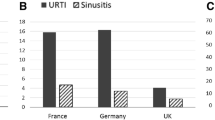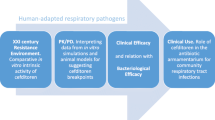Abstract
Respiratory tract infections (RTIs), the most common indication for outpatient antimicrobial therapy, impose a heavy medical and societal burden and present a difficult therapeutic challenge in the face of increasing pathogen resistance worldwide. Gatifloxacin is a new broad-spectrum fluoroquinolone with excellent activity against prevalent respiratory bacteria, including penicillin-resistantStreptococcus pneumoniae and atypical pathogens. A multicenter, open-label, noncomparative surveillance study carried out in Mexico evaluated the safety and efficacy of oral gatifloxacin 400 mg once daily in 17,923 adult outpatients with community-acquired pneumonia (CAP) (n=3322), acute exacerbations of chronic bronchitis (AECB) (n=5885), and acute bacterial sinusitis (n=8716). Voluntary, unpaid physician participation contributed to an unbiased study design. Physician-assessed global rate of cure or improvement was 96.3%; efficacy was 95.8% in CAP, 96.1% in AECB, and 96.4% in sinusitis. The incidences of relapse (1.5%) and therapeutic failure (0.7%) were low. The most commonly reported adverse events, nausea (2.76%), headache (2.20%), and dizziness (1.33%), were generally mild and self-limited. Oral gatifloxacin 400 mg once daily is effective and safe for patients with CAP, AECB, and acute sinusitis.
Similar content being viewed by others
References
Ober NS. Respiratory tract infections: consider the total cost of care.Drug Benefit Trends. 1998; 10:23–29.
Acute respiratory infections: the forgotten pandemic.WHO Bull. 1998;76:101–103.
Niederman MS, Bass JB Jr, Campbell GD, et al. Guidelines for the initial management of adults with community-acquired pneumonia: diagnosis, assessment of severity, and initial antimicrobial therapy.Am Rev Respir Dis. 1993;148:1418–1426.
Bartlett JG, Mundy LM. Community-acquired pneumonia.N Engl J Med. 1995;333:1618–1624.
King DE, Pippin HJ Jr. Community-acquired pneumonia in adults: initial antibiotic therapy.Am Fam Physician. 1997;56:544–550.
Bartlett JG, Breiman RF, Mandell LA, File TM Jr. Guidelines from the Infectious Diseases Society of America. Community-acquired pneumonia in adults: guidelines for management.Clin Infect Dis. 1998;26:811–838.
Leiner S. Acute bronchitis in adults: commonly diagnosed but poorly defined.Nurse Pract. 1997; 22:104–117.
Ball P, Make B. Acute exacerbations of chronic bronchitis. An international comparison.Chest. 1998;113(3 suppl):199S-204S.
Sethi S. Infectious etiology of acute exacerbations of chronic bronchitis.Chest. 2000;117(5 suppl 2): 380S-385S.
Reynolds HY. Chronic bronchitis and acute infectious exacerbations. In: Mandell GL, Bennett JE, Dolin R, eds.Principles and Practice of Infectious Diseases. 5th ed. New York: Churchill Livingstone; 2000:706–710.
Read RC. Infection in acute exacerbations of chronic bronchitis: a clinical perspective.Respir Med. 1999;93:845–850.
Niederman MS. Antibiotic therapy of exacerbations of chronic bronchitis.Semin Respir Infect. 2000;15:59–70.
Chester AC. Chronic sinusitis.Am Fam Physician. 1996;53:877–887.
Sinus and Allergy Health Partnership. Antimicrobial treatment guidelines for acute bacterial sinusitis.Otolaryngol Head Neck Surg. 2000;123:S1-S32.
Sener B, Hascelik G, Onerci M, Tunckanat F. Evaluation of the microbiology of chronic sinusitis.J Laryngol Otol. 1996;110:547–550.
Hoban DJ, Fluitt AC, Roussel-Delvallez M, Doern GV, Jones RN, The Sentry Participants Group. Three year global experience of the SENTRY Antimicrobial Surveillance Program (1997–1999) monitoring community-acquired respiratory tract infection (CARTI) pathogens: results from 17,166 strains ofS. pneumoniae, H. influenzae, andM. catarrhalis. Presented at the 40th Interscience Conference on Antimicrobial Agents and Chemotherapy; September 17–20, 2000; Toronto, Ontario, Canada. Abstract 1220.
Fung-Tomc J, Minassian B, Kolek B, Washo T, Huczko E, Bonner D.In vitro antibacterial spectrum of a new broad-spectrum 8-methoxy fluoroquinolone, gatifloxacin.J Antimicrob Chemother. 2000;45:437–446.
Hershberger E, Rybak MJ. Activities of trovafloxacin, gatifloxacin, clinafloxacin, sparfloxacin, levofloxacin, and ciprofloxacin against penicillin-resistantStreptococcus pneumoniae in an in vitro infection model.Antimicrob Agents Chemother. 2000;44:598–601.
LaCreta FP, Kaul S, Kollia GD, Duncan G, Randall DM, Grasela DM. Interchangeability of 400-mg intravenous and oral gatifloxacin in healthy adults.Pharmacotherapy. 2000;20(6 pt 2): 59S-66S.
Lubasch A, Keller I, Borner K, Koeppe P, Lode H.Comparative pharmacokinetics of ciprofloxacin, gatifloxacin, grepafloxacin, levofloxacin, trovafloxacin, and moxifloxacin after single oral administration in healthy volunteers.Antimicrob Agents Chemother. 2000;44:2600–2603.
Jones RN, Pfaller MA, Wikler M, Nicholson S. Clinical efficacy and safety of gatifloxacin inS. pneumoniae community-acquired pneumonia: initial report from TeqCES. Presented at the 40th Interscience Conference on Antimicrobial Agents and Chemotherapy; September 17–20, 2000; Toronto, Ontario, Canada. Abstract 817.
Talan DA. New concepts in antimicrobial therapy for emergency department infections.Ann Emerg Med. 1999;34:503–516.
Blondeau JM. A review of the comparative in-vitro activities of 12 antimicrobial agents, with a focus on five new ‘respiratory quinolones.’J Antimicrob Chemother. 1999;43(suppl B):1–11.
Pfaller MA, Jones RN, Wikler M, Von Seggern K. Geographic variation in antimicrobial resistance among respiratory pathogens from US outpatients: initial report from the RESP study of community-acquired respiratory tract infections (CARTI). Presented at the 40th Interscience Conference of Antimicrobial Agents and Chemotherapy; September 17–20, 2000; Toronto, Ontario, Canada. Abstract 600.
Nicholson SC, Russo RL, Wikler MA. Differences in susceptibility ofS. pneumoniae isolated from patients with community-based respiratory tract infections. Presented at the 38th Annual Meeting of the Infectious Diseases Society of America; September 7–10, 2000; New Orleans, La. Abstract 200404.
Ramirez J, Nguyen T-H, Tellier G, et al. Once-daily 400 mg oral gatifloxacin (GAT) vs twicedaily 500 mg oral clarithromycin (CLA) in the treatment of community-acquired pneumonia (CAP). Presented at the 39th Interscience Conference on Antimicrobial Agents and Chemotherapy; September 26–29,1999; San Francisco, Calif. Abstract 2242.
Gotfried M, Sullivan JG, Mayer H, Plouffe J. A randomized, double-blind, multicenter, comparative study of gatifloxacin vs levofloxacin in the treatment of community-acquired pneumonia. Presented at the 39th Interscience Conference on Antimicrobial Agents and Chemotherapy; September 26–29,1999; San Francisco, Calif. Abstract 2243.
DeAbate CA, McIvor RA, McElvaine P, Skuba K, Pierce PR. Gatifloxacin vs cefuroxime axetil in patients with acute exacerbations of chronic bronchitis.J Respir Dis. 1999;20(suppl 11):S23-S29.
López-Sisniega JA, Belalcázar V, Mascareño A, et al. Gatifloxacin in the treatment of acute bacterial sinusitis (ABS) in Mexico. Presented at the 39th Interscience Conference on Antimicrobial Agents and Chemotherapy; September 26–29,1999; San Francisco, Calif. Abstract 0166.
King DE, Malone R, Lilley SH. New classification and update on the quinolone antibiotics.Am Fam Physician. 2000;61:2741–2748.
Conder ML, Lawrence JH, Levesque PC, Blanar MA. Inhibition of the HERG potassium channel by fluoroquinolone antibacterials: correlation with risk for clinically significant QT interval prolongation. Presented at the 40th Interscience Conference on Antimicrobial Agents and Chemotherapy; September 17–20,1999; Toronto, Ontario, Canada. Abstract 810.
Author information
Authors and Affiliations
Rights and permissions
About this article
Cite this article
Casillas, J.L., Rico, G., Rodríguez-Parga, D. et al. Multicenter evaluation of the efficacy and safety of gatifloxacin in Mexican adult outpatients with respiratory tract infections. Adv Therapy 17, 263–271 (2000). https://doi.org/10.1007/BF02850009
Issue Date:
DOI: https://doi.org/10.1007/BF02850009




